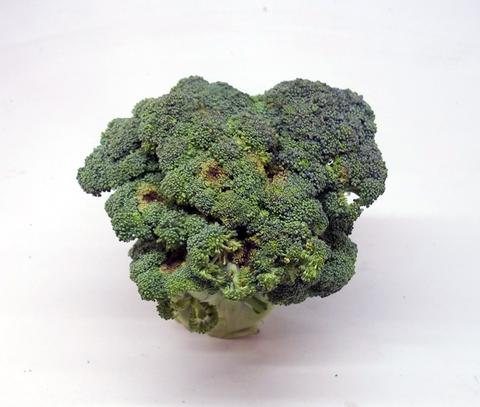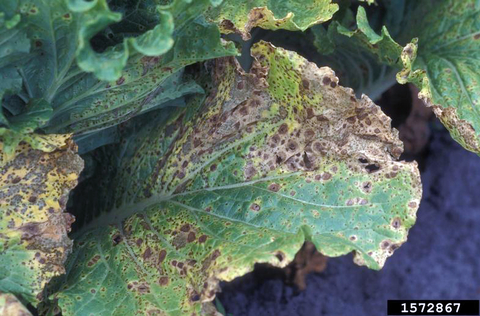Quick facts
- Alternaria is one of the most common diseases of broccoli, kale, and other Brassica crops.
- It is sometimes referred to as black spot.
- It affects leaves, and often results in head rot. It can be severely yield limiting.
- While this disease is not new, it has become worse in recent years, particularly on broccoli, and to some extent, cauliflower.
How to tell Alternaria from other brassica problems
- Leaf symptoms include round, brown spots with concentric rings.
- Spots often have a yellow halo, and can crack through the middle.
- Spots often occur first on older leaves.
- As the disease spreads, leaves can develop enough spots that they begin to meld together to create large necrotic areas on leaves.
- Head rot symptoms can first appear as small brown spots on an otherwise healthy head.
- Heads with rot symptoms deteriorate quickly.
Biology
- Alternaria is potentially caused by three pathogens: Alternaria brassicicola, A. brassicae, and A. raphani. Based on initial screenings, the primary species causing disease in Minnesota broccoli is Alternaria brassicicola.
- Alternaria is a fungus. It produces spores, which can be spread via wind, water and equipment.
- This fungus can infect any plant in the Brassica family, but tends to be most damaging in broccoli and cauliflower.
- Alternaria can enter farms through infected seeds.
- Once present, Alternaria can persist in residues. In some cases, Alternaria fungi will develop resting spores that allow them to survive in the soil.
- This disease spreads in warm temperatures (60-78 degrees F), and during periods of high humidity (90% RH).
Managing Alternaria in the home garden
Varieties that we recommend based on high performance in both research station and grower trials for broccoli planted in June include Wolfman, Green Magic and Eastern Crown.
For late-planted broccoli, Asteroid, Imperial, Luna, Monty, Diplomat, Abrams and Eastern Crown are all varieties that growers liked. Eastern Crown, Diplomat, Imperial and Abrams had the best disease tolerance in 2022. During seasons when disease pressure is expected to remain low, these varieties could all be good choices
Read the summary report of research done in 2021 and 2022. For a full list of recommendations for varieties to plant in spring and summer.
- Buy clean seed from reputable companies.
- If you save a seed, save seed only from healthy plants
- Consider heat treating your seed.
- Remove or bury residues in your garden.
- Let three years pass before you plant Brassica plants in the same location.
- Do not use cover crops in the Brassica family, such as tillage radish, if this disease has been a problem for you.
- Increase airflow by spacing plants adequately apart. Ideal broccoli spacing is 10–18 inches apart in rows 18–36 inches apart.
- Pay close attention to weeds in the Brassica family such as shepherd’s purse, black mustard and field mustard. Remove them from your garden so they do not act as hosts for black rot.
- Clean and sanitize trays used for starting seeds each year.
If symptoms are limited to a few plants, remove infected plants as soon as symptoms appear. Be sure to remove the entire plant, not just the leaves. If all plants are affected, remove infected leaves.
If you touch infected leaves, wash your hands well before working in healthy Brassica plants. If you use pruning tools, wash and sanitize them after touching infected plants.
- Most home gardeners don’t need to treat Alternaria with fungicides.
- Fungicides are curative rather than preventative, so if your Brassicas already have substantial damage from Alternaria, a fungicide will not undo damage.
- Focus on good cultural and physical controls.
Managing Alternaria on farms
- Alternaria can appear in early spring in Minnesota, especially if it is seedborne.
- Check transplants for dark brown spots.
- It often becomes widespread in the field in late summer as temperatures and humidity increase.
- Scout often for initial symptoms, especially if high humidity is forecasted.
In a broccoli screening project conducted in 2021 and 2022 at the Southern Research and Outreach Center in Waseca and at 80 collaborating farms and gardens, we identified varieties that performed well under heavy disease pressure. Read the summary report, which has recommendations for varieties to plant in spring and summer.
- Buy seeds from companies that screen for Alternaria. Check with your local seed rep if this information is not readily available.
- Screen transplants for symptoms before bringing them into the field.
- Let three years pass before you plant Brassicas in the same location.
- Avoid over-fertilizing; Alternaria symptoms can be worse in fields with too much nitrogen.
- Avoid planting Brassica crops in fields with poor drainage, or fields that may receive runoff from fields where Brassicas were recently grown.
- Avoid working in plants when they are wet from rain, irrigation, or dew.
- Increase airflow by spacing plants adequately apart. Ideal broccoli spacing is 10–18 inches apart in rows 18–36 inches apart.
- Avoid using tillage radish, winter camelina, and other Brassicas as cover crops.
- Destroy crop debris immediately after harvest by flail mowing or tilling.
- Pay close attention to weeds in the Brassica family such as shepherd’s purse, black mustard and field mustard. Remove them from your garden so they do not act as hosts for black rot.
- Clean and sanitize trays used for starting seeds each year, as well as any equipment used in fields with disease pressure.
Many fungicides are labeled for Alternaria. In some states, Alternaria japonica has shown resistance to fungicides in group 11. As of 2023, only Alternaria brassicicola has been found in Minnesota.
Keep in mind that fungicides are preventative rather than curative, so applications should begin when symptoms first appear and conditions are right for disease development.
See the Midwest Vegetable Production Guide for current recommendations.
CAUTION: Mention of a pesticide or use of a pesticide label is for educational purposes only. Always follow the pesticide label directions attached to the pesticide container you are using. Be sure that the plant you wish to treat is listed on the label of the pesticide you intend to use. And observe the number of days between pesticide application and when you can harvest your crop. Remember, the label is the law.
Reviewed in 2023





